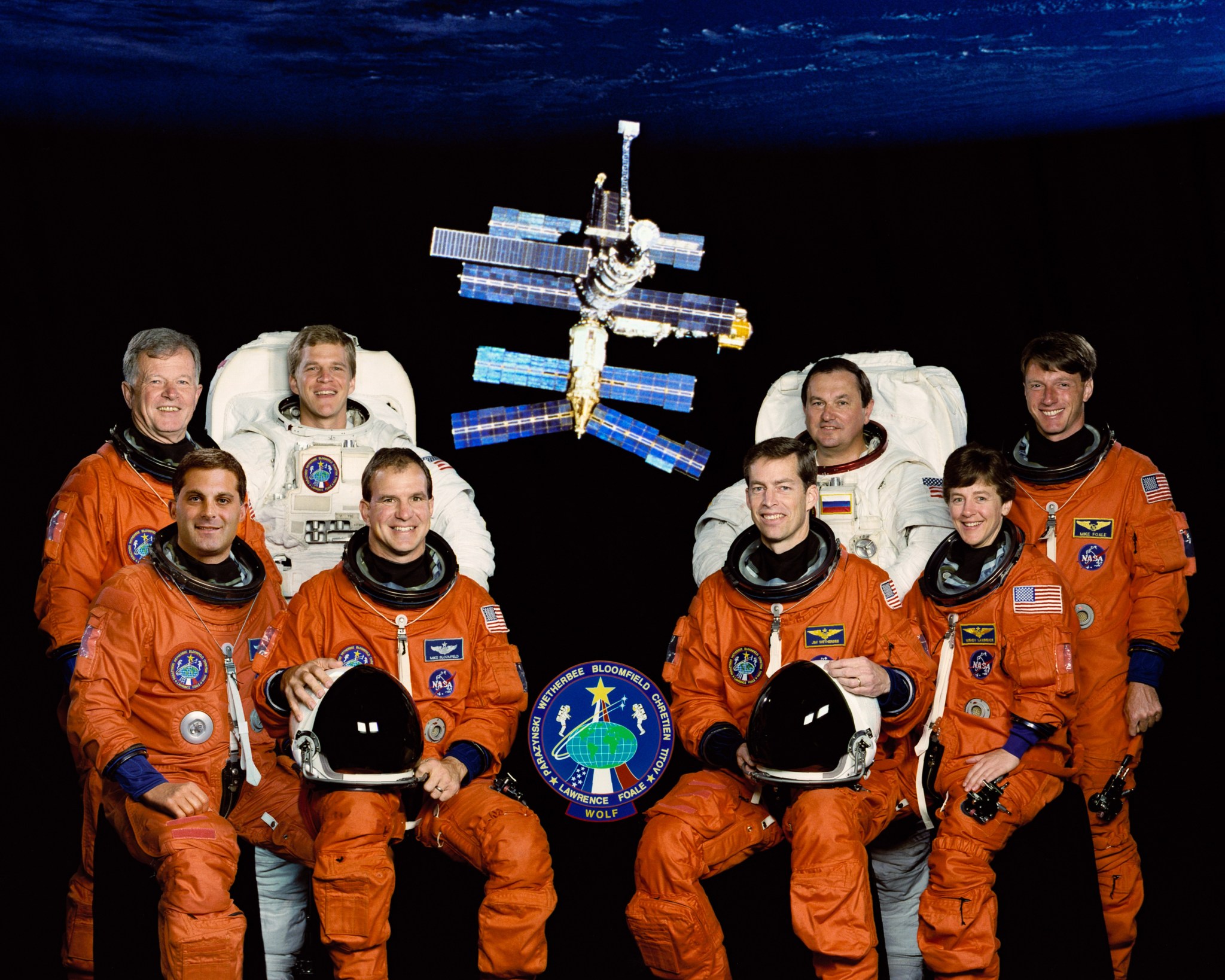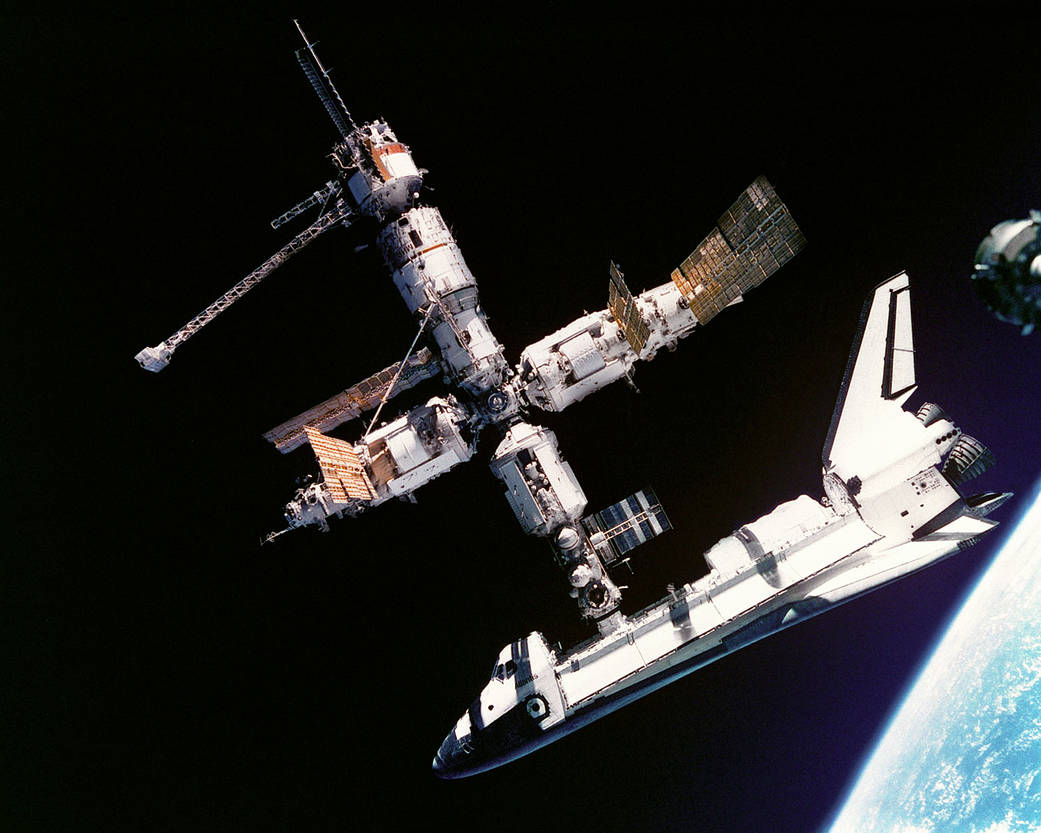
STS-86
STS-86 performed the seventh Shuttle-Mir docking and continued the presence of a U.S. astronaut onboard Mir, by transferring the sixth U.S. Mir astronaut David Wolf, in exchange for Michael Foale, who returned to Earth after 145 days in space. Foale had experienced the collision, June 25, 1997, between a Progress resupply vehicle and Mir's Spektr module.
Orbiter
Mission Duration
Launch
Landing

Mission Facts
Mission: Seventh Shuttle-Mir Docking
Space Shuttle: Atlantis
Launch Pad: 39A
Launched: September 25, 1997, 10:34:19 p.m. EDT
Landing Site: Kennedy Space Center, Florida
Landing: October 6, 1997, 5:55:09 p.m. EDT
Runway: 15
Rollout Distance: 11,947 feet
Rollout Time: 82 seconds
Revolution: 170
Mission Duration: 10 days, 19 hours, 20 minutes, 50 seconds
Orbit Altitude: 184 statute miles
Orbit Inclination: 51.6 degrees
Crew
James Wetherbee, Commander
Mike Bloomfield, Jr., Pilot
Wendy Lawrence, Mission Specialist
David A. Wolf, Mission Specialist
Michael Foale, Mission Specialist
Vladimir Titov, Mission Specialist
Scott Parazynski, Mission Specialist
Jean-Loup Chretien, Mission Specialist
Launch Highlights
On-time liftoff occurred after final approval for flight to Mir given earlier in the day by NASA Administrator Daniel Goldin, following his review of independent and internal safety assessments regarding safety of Mir and Shuttle-Mir missions. The reviews included assessments conducted routinely prior to Shuttle-Mir dockings and two independent studies prompted by a spate of problems on the station, including a fire (STS-84) and a collision (STS-86).
Mission Highlights
The seventh Mir docking mission continued the presence of a U.S. astronaut on the Russian space station with the transfer of physician David A. Wolf to Mir. Wolf became the sixth U.S. astronaut in succession to live on Mir to continue Phase 1B of the NASA/Russian Space agency cooperative effort.
Foale returned to Earth after spending 145 days in space, 134 of them aboard Mir. His estimated mileage logged was 58 million miles (93 million kilometers), making his the second longest U.S. space flight, behind Shannon Lucid’s record of 188 days. His stay was marred by a collision June 25 between a Progress resupply vehicle and the station’s Spektr module, damaging a radiator and one of four solar arrays on Spektr. The mishap occurred while Mir 23 Commander Vasily Tsibliev was guiding the Progress capsule to a manual docking and depressurized the station. The crew sealed the hatch to the leaking Spektr module, leaving inside Foale’s personal effects and several NASA science experiments, and repressurized the remaining modules.
An internal space walk by Tsibliev and Mir 23 Flight Engineer Alexander Lazutkin was planned to reconnect power cables to the three undamaged solar arrays, but during a routine medical exam July 13 Tsibliev was found to have an irregular heartbeat. Foale then began training for the space walk, but during one of the training exercises a power cable was inadvertently disconnected, leaving the station without power. On July 21, it was announced that the internal space walk would not be conducted by the Mir 23 crew but their successors on Mir 24. On July 30, NASA announced that Wendy Lawrence, originally assigned to succeed Foale on Mir, was being replaced by Wolf. The change was deemed necessary to allow Wolf to act as a backup crew member for the space walks planned over the next several months to repair Spektr. Unlike Wolf, Lawrence could not fit in the Orlan suit that is used for Russian space walks and she did not undergo space walk training.
Following their arrival at the station Aug. 7, Mir 24 Commander Antaoly Solovyev and Flight Engineer Pavel Vinogradov conducted the internal space walk inside the depressurized Spektr module Aug. 22, reconnecting 11 power cables from the Spektr’s solar arrays to a new custom-made hatch for the Spektr. During the space walk, Foale remained inside the Soyuz capsule attached to Mir, in constant communication with the cosmonauts as well as ground controllers.
On Sept. 5, Foale and Solovyev conducted a six-hour external extravehicular activity to survey damage outside Spektr and to try and pinpoint where the breach of the module’s hull occurred. Two undamaged arrays were manually repositioned to better gather solar energy, and a radiation device left previously by Jerry Linenger was retrieved.
Docking of Atlantis and Mir took place at 3:58 p.m. EDT, Sept. 27, with the two mission commanders opening the spacecraft hatches at 5:45 p.m. Wolf officially joined the Mir 24 at noon EDT, Sept. 28. At the same time, Foale became a member of the STS-86 crew and began moving his personal belongings back into Atlantis. Wolf will be replaced by the seventh and last U.S. astronaut to transfer to Mir, Andrew S. W. Thomas, when the orbiter Endeavour docks with the Russian space station during the STS-89 mission in January 1998.

First joint U.S.-Russian extravehicular activity during a shuttle mission, which was also the 39th in the space shuttle program, was conducted by Titov and Parazynski. During the five-hour, one-minute space walk on Oct. 1, the pair affixed a 121-pound Solar Array Cap to the docking module for future use by Mir crew members to seal off the suspected leak in Spektr’s hull. Parazynski and Titov also retrieved four Mir Environmental Effects Payloads (MEEPS) from the outside of Mir and tested several components of the Simplified Aid for EVA Rescue (SAFER) jet packs. The space walk began at 1:29 p.m. EDT and ended at 6:30 p.m.
During the six days of docked operations, the joint Mir 24 and STS-86 crews transferred more than four tons of material from the SPACEHAB Double Module to Mir, including approximately 1,700 pounds of water, experiment hardware for International Space Station Risk Mitigation experiments to monitor the Mir for crew health and safety, a gyrodyne, batteries, three air pressurization units with breathing air, an attitude control computer and many other logistics items. The new motion control computer replaced one that had experienced problems in recent months. The crew also moved experiment samples and hardware and an old Elektron oxygen generator to Atlantis for return to Earth. Undocking took place at 1:28 p.m. EDT, Oct 3. After undocking, Atlantis performed a 46-minute flyaround visual inspection of Mir. During this maneuver, Solovyev and Vinogradov opened a pressure regulation valve to allow air into the Spektr module to see if STS-89 crew members could detect seepage or debris particles that could indicate the location of the breach in the damaged module’s hull.
During the flight, Wetherbee and Bloomfield fired small jet thrusters on Atlantis to provide data for the Mir Structural Dynamics Experiment (MISDE), which measures disturbances to space station components and its solar arrays. Other experiments conducted during the mission were the Commercial Protein Crystal Growth investigation; the Cell Culture Module Experiment (CCM-A), the Cosmic Radiation Effects and Activation Monitor (CREAM) and the Radiation Monitoring Experiment-III (RME-III); the Shuttle Ionospheric Modification with Pulsed Local Exhaust (SIMPLE) experiment; and the Midcourse Space Experiment. Two NASA educational outreach programs were also conducted, Seeds in Space-II and Kidsat.
Orbiter performance was nominal.
STS-86
Shuttle News
Retired Space Shuttle Locations
Shuttle Atlantis – Kennedy Space Center Visitor Complex Shuttle Discovery – Steven F. Udvar-Hazy Center Shuttle Endeavour – California Science…
Read the Story













































